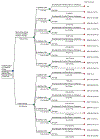Paying Low-Income Smokers to Quit? The Cost-Effectiveness of Incentivizing Tobacco Quit Line Engagement for Medicaid Recipients Who Smoke
- PMID: 30711062
- PMCID: PMC6362459
- DOI: 10.1016/j.jval.2018.08.001
Paying Low-Income Smokers to Quit? The Cost-Effectiveness of Incentivizing Tobacco Quit Line Engagement for Medicaid Recipients Who Smoke
Abstract
Objectives: To determine the cost-effectiveness of an incentive-based stop-smoking intervention that paid Medicaid recipients who smoke to take calls from a tobacco quit line.
Methods: A cost-effectiveness analysis was conducted alongside a randomized controlled trial. The analysis was conducted from a health care systems perspective on the basis of costs and effectiveness over a 6-month follow-up. Participants (n = 1900) were recruited from May 2013 to June 2015 through quit line (n = 980), clinic-based (n = 444), or community-based (n = 476) referrals. Incentive group participants (n = 948) received $30 a call for taking up to five tobacco quit line calls and $40 for biochemically verified tobacco abstinence at 6 months. Control group participants (n = 952) did not receive financial incentives for taking quit line calls. Intervention resource costs included incentive payments to participants, counselor and administrative staff time, and smoking cessation medications. Smoking status at baseline and 6 months was determined for all study participants via carbon monoxide (CO) breath tests (abstinence: CO < 7 ppm). Cost-effectiveness analysis calculated the incremental cost-effectiveness ratio (ICER).
Results: Incentive treatment produced higher 6-month CO-confirmed 7-day point-prevalence abstinence than did the control treatment (21.6 vs. 13.8%; P < 0.001). The ICER of the financial incentives intervention was $2316 (95% confidence interval $1582-$4270) per additional person who quit. The study ICER compares favorably with other smoking treatments, such as varenicline combined with proactive telephone counseling, whose ICER has been estimated at $2600 per additional smoker who quits.
Conclusions: Use of financial incentives to engage with tobacco quit line treatment is a cost-effective option to enhance smoking cessation rates for low-income smokers.
Keywords: Medicaid; clinical trials; cost-effectiveness; smoking and tobacco.
Copyright © 2019 ISPOR–The Professional Society for Health Economics and Outcomes Research. Published by Elsevier Inc. All rights reserved.
Figures

References
-
- Kotz D, West R. Explaining the social gradient in smoking cessation: it’s not in the trying, but in the succeeding. Tob Control. 2009;18(1):43–46. - PubMed
-
- Hiscock R, Judge K, Bauld L. Social inequalities in quitting smoking: what factors mediate the relationship between socioeconomic position and smoking cessation? J Public Health. 2011;33(1):39–47. - PubMed
Publication types
MeSH terms
Grants and funding
LinkOut - more resources
Full Text Sources
Medical
Miscellaneous

